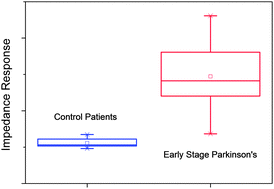The robust electrochemical detection of a Parkinson's disease marker in whole blood sera
Abstract

* Corresponding authors
a
Department of Chemistry, University of Oxford, Oxford, UK
E-mail:
Jason.davis@chem.ox.ac.uk
Fax: +44 (0)1865 275410
Tel: +44 (0)1865 275914
b Key Laboratory of Biochemical Analysis, Ministry of Education, College of Chemistry and Molecular Engineering, Qingdao University of Science and Technology, Qingdao 266042, China
c Department of Pharmacology and Clinical Neuroscience, Umeå University, SE 901875 Umeå, Sweden
d Department of Medical Biochemistry and Biophysics, Umeå University, SE 901875 Umeå, Sweden

 Please wait while we load your content...
Something went wrong. Try again?
Please wait while we load your content...
Something went wrong. Try again?
T. Bryan, X. Luo, L. Forsgren, L. A. Morozova-Roche and J. J. Davis, Chem. Sci., 2012, 3, 3468 DOI: 10.1039/C2SC21221H
To request permission to reproduce material from this article, please go to the Copyright Clearance Center request page.
If you are an author contributing to an RSC publication, you do not need to request permission provided correct acknowledgement is given.
If you are the author of this article, you do not need to request permission to reproduce figures and diagrams provided correct acknowledgement is given. If you want to reproduce the whole article in a third-party publication (excluding your thesis/dissertation for which permission is not required) please go to the Copyright Clearance Center request page.
Read more about how to correctly acknowledge RSC content.
 Fetching data from CrossRef.
Fetching data from CrossRef.
This may take some time to load.
Loading related content
